USS Ronald Reagan
 USS Ronald Reagan in the Straits of Magellan in 2004 | |
| History | |
|---|---|
| Name: | USS Ronald Reagan |
| Namesake: | Ronald Reagan |
| Ordered: | 8 December 1994 |
| Builder: | Northrop Grumman Newport News |
| Laid down: | 12 February 1998 |
| Launched: | 4 March 2001 |
| Sponsored by: | Nancy Reagan |
| Commissioned: | 12 July 2003 |
| Homeport: | |
| Identification: |
|
| Motto: | Peace Through Strength |
| Nickname(s): | Gipper |
| Status: | in active service |
| Badge: |
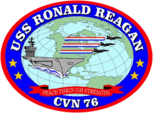 |
| General characteristics | |
| Class and type: |
|
| Displacement: | 101,400 long tons (113,600 short tons)[1] |
| Length: |
|
| Beam: |
|
| Draft: |
|
| Propulsion: |
|
| Speed: | 30+ knots (56+ km/h; 35+ mph) |
| Range: | Unlimited distance; 20–25 years |
| Complement: |
|
| Sensors and processing systems: |
|
| Electronic warfare & decoys: |
|
| Armament: | |
| Armor: | Unknown |
| Aircraft carried: | 90 fixed wing and helicopters |
USS Ronald Reagan (CVN-76) is a Nimitz-class, nuclear-powered supercarrier in the service of the United States Navy. The ninth ship of her class,[2] she is named in honor of Ronald W. Reagan, President of the United States from 1981 to 1989. Upon her christening in 2001, she was the first ship to be named for a then-still living former president.
As of May 2012, the ship was operationally part of Carrier Strike Group Nine and administratively under the command of Commander, Naval Air Forces Pacific/Commander, Naval Air Forces. The two administrative titles actually refer to one command carrying out two functions. In October 2015, Ronald Reagan replaced USS George Washington as the flagship of Carrier Strike Group Five, the only forward-based carrier strike group home-ported at Yokosuka, Japan, as part of the United States Seventh Fleet.[3]
Design and construction
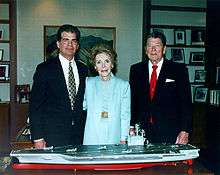
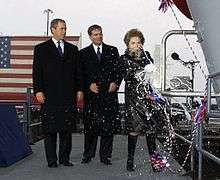
.jpg)
The contract to build Ronald Reagan was awarded to Northrop Grumman Newport News Shipbuilding and Dry Dock Company in Newport News, Virginia, on 8 December 1994, and her keel was laid down on 12 February 1998. The budget for the ship had to be increased several times, and ultimately $4.5 billion were spent on her construction.[4] This included a redesigned ship island.[5] Ronald Reagan was christened by Reagan's wife Nancy on 4 March 2001 at Newport News Shipbuilding, the crew moved aboard on 30 October 2002,[6] and the ship was commissioned on 12 July 2003 at Naval Station Norfolk, with Captain J. W. Goodwin in command. Vice President Dick Cheney and Lynne Cheney were both present at the ceremony, as well as Nancy Reagan, who gave the ship's crew the traditional first order as an active unit of the Navy: "Man the ship and bring her to life." Ronald Reagan made her maiden voyage on 21 July 2003. President Reagan, who did not attend either the launch or the commissioning due to Alzheimer's disease, died 11 months later. At the end of the graveside services, the ship's commanding officer at that time, Captain James Symonds, presented the flag that draped the former president's casket to Mrs. Reagan at her request. This was also the flag that had flown over Capitol Hill on 20 January 1981, when the president was inaugurated. At a later date, Captain Symonds also presented Mrs. Reagan the flag that had been flying over Ronald Reagan when the former president died.
Naming
Ronald Reagan was the first nuclear-powered warship of any kind to be named in honor of a living former president.[7] Unlike most of the other men honored by inclusion in this group, Reagan was not associated with the United States Navy, apart from his term as Commander-in-Chief, though one of his key initiatives in office was the 600-ship Navy program.
Ship's seal
The design of Ronald Reagan's seal was created entirely by her plankowner crew with historical assistance provided by staff members at the Ronald Reagan Presidential Library foundation. The red border that rings the ship's seal is similar to the distinctive red rim that defines the White House china designed for the Reagans during their White House years. Four gold stars represent President Reagan's 40th presidency and his four pillars of freedom: individual liberty, economic opportunity, global democracy, and national pride. "Peace through Strength" was a recurring theme of the President's life in public service. The aircraft carrier is positioned by the West Coast, representing President Reagan's two terms as Governor of California and the ship's homeport in the Pacific Fleet. The three aircraft with their patriotic contrails symbolize the three major military operations the President directed during his tenure: Operation Urgent Fury (Grenada/1983), Operation El Dorado Canyon (Libya/1986), and Operation Praying Mantis (Iran/1988). The view of the globe signifies the President's vision of global democracy, and the center is the United States representing the country's national pride. Colors of red, white, and blue dominate the seal reflecting the American flag.[8]
Service history
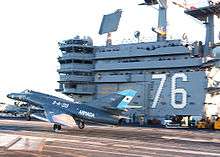
On 8 May 2004, following her five-month post-shakedown availability, Ronald Reagan received her second flight deck certification which encompassed all flight operations, including aircraft launch and recovery, safety, crash and salvage, fuel certifications, and training.[9] Ronald Reagan then began her transit from Naval Station Norfolk, Virginia, through the straits of Magellan, South America, to her new homeport of Naval Air Station North Island, San Diego, with James A. Symonds in command.
Carrier Air Wing Eleven, normally assigned to USS Nimitz, embarked only 25% of its total strength for the transit. The squadrons making the transit were VFA-14 and VFA-41 flying the F/A-18E/F Super Hornet, VAW-117 flying the E-2C Hawkeye 2000, HS-6 flying the SH-60F Seahawk, and VRC-30 flying the C-2A Greyhound. The ship visited Rio de Janeiro, Brazil, on 5 June 2004, and during the first evening after arrival, the ship's namesake, Ronald Reagan, died. A ceremony in his honor was held onboard later that evening, soon after the US national anthem was publicly played. After leaving Rio, Ronald Reagan transited the Strait of Magellan on 20–21 June and subsequently made port visits to Valparaíso, Chile, and Callao, Peru, before arriving in San Diego on 23 July 2004. From 1 October 2004, Ronald Reagan was assigned to Carrier Strike Group Fifteen.
2006 maiden deployment
%2C_foreground%2C_USS_Kitty_Hawk_(CV_63)%2C_center%2C_USS_Abraham_Lincoln_(CVN_72)_and_their_associated_carrier_strike_groups_steam_in_formation.jpg)
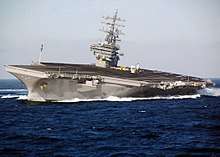
Ronald Reagan, now with Terry B. Kraft in command, departed San Diego on 4 January 2006, on her maiden deployment to conduct naval operations in support of Operation Iraqi Freedom and Operation Enduring Freedom, as well as to conduct maritime security operations in the Persian Gulf. On 28 January 2006, an F/A-18 Hornet strike fighter attempting a night landing aboard Ronald Reagan crashed into the ship's flight deck about 200 km (120 mi) southeast of Brisbane, Queensland. The aircraft struck the ramp at a low angle, caught fire, and skidded overboard. The pilot ejected safely, but the aircraft was lost.[10][11] While in the port of Brisbane, the carrier's condensors became fouled with jellyfish, causing minor problems.[12][13] The ship entered the Persian Gulf on 22 February 2006, and returned from deployment on 6 July 2006.[14][15]
2007 surge deployment
Ronald Reagan and her Carrier Strike Group (CSG) departed North Island, Coronado in San Diego on 27 January 2007 on an unscheduled surge deployment[16] to the Western Pacific, fulfilling the role of the forward deployed carrier Kitty Hawk while it underwent maintenance in Japan. On 20 April 2007, Ronald Reagan and her CSG returned to Coronado. The "surge deployment" was part of the Navy's Fleet Response Plan, which provides the US with the ability to respond to any global commitment with flexible and sustainable forces and the ability to rapidly respond to a range of situations on short notice.
In January 2007, it was announced that Ronald Reagan had earned the 2006 Commander, Naval Air Forces Pacific Carrier Battle Efficiency "E" award for the West Coast, the first Battle "E" ever for the carrier.[17]
Ronald Reagan returned to Naval Air Station North Island on 20 April 2007, following the three-month deployment in support of operations in the Western Pacific.
On 15 December 2007, the carrier answered a distress call from a cruise ship off the coast of Baja California. An Illinois teenager whose appendix had ruptured while on a Mexican cruise was airlifted by an SH-60 helicopter to Ronald Reagan, where an emergency appendectomy was performed by the ship's surgeon.[18][19]
2008 deployment
USS Ronald Reagan, with CVW-14 embarked, departed San Diego on 19 May 2008, for a scheduled 7th Fleet and 5th Fleet deployment.
The Ronald Reagan CSG performed humanitarian assistance and disaster relief operations in the Philippines on 24 June 2008 after that country was devastated by Typhoon Fengshen, killing hundreds from the central island regions and the main island of Luzon. The typhoon also capsized the passenger ferry MV Princess of the Stars.[20] Working in support of the Armed Forces of the Philippines, Ronald Reagan and her escorts of CSG 7 focused their efforts on the island of Panay in the Central Visayas. For eight days, SH-60 Seahawk helicopters and C-2A Greyhound aircraft of the Ronald Reagan CSG helped deliver more than 519,000 lb (235,000 kg) of rice, fresh water, and other supplies to areas of Panay, which were not reachable by truck due to flooded roads. The mission in Panay earned the entire strike group the Navy's Humanitarian Service Medal.
The CSG arrived in the U.S. Fifth Fleet area on 28 August 2008, where she launched more than 1,150 sorties into Afghanistan in support of Operation Enduring Freedom. Ronald Reagan returned to San Diego on 25 November 2008.
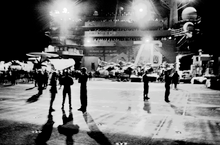
Ronald Reagan received word in February 2009 that the ship had won her second Battle Efficiency Award.[21]
2009 deployment
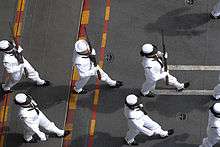
On 28 May 2009, Ronald Reagan deployed with Carrier Air Wing 14 to the 7th and 5th Fleet Areas of Responsibility.[22] Ronald Reagan relieved the Dwight D. Eisenhower CSG and launched her first sorties in support of OEF on 6 July. Ronald Reagan returned to homeport on 21 October after a five-month deployment.[23]
2010
In early 2010, Ronald Reagan was awarded the 2009 Chief of Naval Operations Afloat Safety "S" Award,[24] and the 2009 Pacific Fleet Battle "E" for combat efficiency. The Battle "E" award was Ronald Reagan's second consecutive and third in four years.[25]
%2C_USS_Nimitz_(CVN_68)_and_USS_Carl_Vinson_(CVN_70)_are_pierside_at_Naval_Air_Station_North_Island.jpg)
On 19 May 2010, Norfolk Naval Shipyard completed the six-month Planned Incremental Availability (PIA) maintenance cycle on Ronald Reagan. This PIA project came in under budget, and it marked both Norfolk Naval Shipyard's largest off-site availability, as well as the largest public-sector work package ever performed on an aircraft carrier berthed at Naval Air Station North Island located near Coronado, California (pictured).[26] During the maintenance period, Ronald Reagan received technological upgrades that prepared her for her next deployment and subsequent operations. Refurbishments included high-tech combat systems and firefighting equipment to improved ship's laundry services and living spaces.[27] This PIA maintenance project was an example of the 'One Shipyard' concept wherein the US Navy mobilizes its work force across its various shipyards to better meet fleet readiness requirements and to stabilize a vital workforce base for the US defense industry. While Norfolk Naval Shipyard (NNSY) was the project lead, significant work was done by its partners: Puget Sound Naval Shipyard & Intermediate Maintenance Facility (PSNS), Southwest Regional Maintenance Center (SRMC), and Northrop Grumman Shipbuilding (NGSB). During peak manning, about 1,400 worked the project on a daily basis. This included rough 625 NNSY personnel, 165 PSNS employees, and 600 from SWRMC/NGSB.[26]
On 18 May 2010, Ronald Reagan departed Naval Air Station North Island for sea trials.[27][28][29] This was the final phase of the PIA, and it was conducted to assess the carrier's material readiness to return to the operational fleet.[27] Ronald Reagan pulled into Naval Air Station North Island on 19 May 2010 after completing her two-day sea trial, marking the official end to the ship's six-month PIA maintenance period.[27]
On 2 June 2010, Ronald Reagan, with Carrier Air Wing Fourteen (CVW-14) embarked, departed Naval Air Station North Island to conduct flight deck certifications.[29][30] Embarked squadrons included: Helicopter Antisubmarine Squadron 4 (HS-4), Marine Fighter Attack Squadron 323 (VMFA-323), Strike Fighter Squadron 154 (VFA-154), Strike Fighter Squadron 147 (VFA-147)* Strike Fighter Squadron 146 (VFA-146), Airborne Early Warning Squadron 113 (VAW-113) and Fleet Logistics Squadron 30 (VRC-30). The certification included a full evaluation of the arresting gear, steam catapults, and flight-deck personnel. Ronald Reagan's air department was assessed on its ability to maintain a fully operational flight deck and respond to simulated mishaps.[30]
During the summer of 2010, Ronald Reagan participated in Exercise RIMPAC, departed from Naval Air Station North Island, California, for a Board of Inspection and Survey assessment on 25 August 2010, and departed her homeport to conduct routine operations off the coast of southern California in preparation for her 2011 Western Pacific (WESTPAC) deployment.[29] In November 2010, the ship provided emergency supplies and assistance to passengers stranded in the Pacific Ocean aboard the Carnival Splendor, which had lost power by an engine fire.[31]
2011
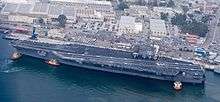
The ship departed for an Asian deployment on 2 February 2011. On 11 March 2011, Ronald Reagan was in the Korean peninsula region for a long-planned exercise off Korea, but was redirected towards Japan to provide support after the massive 2011 Tōhoku earthquake and tsunami. The ship, stationed off Sendai, served as a refueling station for Japanese coast guard and military helicopters on relief missions in the area.[32] US Navy helicopters also flew relief missions from the carrier. On 13 March 2011, the ship measured 0.6 mR/hr direct gamma shine from clouds 130 miles (≈210 km) from the Fukushima Daiichi Nuclear Power Plant.[33] Members of the crew blamed their cancers on the event.[34] On 14 March 2011, the ship was forced to relocate to avoid a radioactive plume from the Fukushima I nuclear accidents which had contaminated 17 crew members of three helicopter crews.[35] On 23 March, Ronald Reagan's crew performed radiation decontamination by scrubbing down any surface that could have been contaminated, including the island superstructure and flight deck, to remove any potential radiation hazards.[36] On 4 April 2011, Japan's minister of defense, Toshimi Kitazawa, accompanied by US ambassador to Japan John Roos, visited the ship to thank the crew for their assistance as part of Operation Tomodachi. Said Kitazawa, "I have never been more encouraged by and proud of the fact that the United States is our ally."[37] The ship returned to San Diego on 8 September 2011.[38] In January 2011, the Navy announced that the aircraft carrier would be transferred to the Puget Sound Naval Ship Yard in Bremerton, Washington, for scheduled repair and maintenance beginning January 2012.
2012 and 2013
_transports_Sailors'_vehicles_while_transiting_the_Pacific_coast_to_Naval.jpg)
On 10 January 2012, Ronald Reagan's official home port was changed to Bremerton, Washington, where she stayed for a little over a year[39] until returning to her home port of San Diego on 21 March 2013.[40] For the sailors being relocated, the Navy had many of their vehicles transported on the deck of the ship as a cost-saving measure.[41][42]
2014
On 14 January 2014, the Navy announced that Ronald Reagan would replace her sister ship George Washington as the Seventh Fleet forward deployed carrier at Yokosuka, Japan in 2015.[43]
2015
In 2015 the Ronald Reagan replaced USS George Washington (CVN-73) in Japan as the US Navy's only forward deployed aircraft carrier and took her new place as the flagship of Carrier Strike Group Five and Carrier Air Wing Five (CVW-5). On 1 October 2015, Ronald Reagan arrived in her newest home port, Yokosuka in Kanagawa Prefecture. CVW-5 was based at Naval Air Facility Atsugi, which is also located in Kanagawa Prefecture. The ship was open for the public to tour on 12 October.[3]
On 29 October two Russian Tupolev Tu-142 bombers flew within one mile of the ship at low altitude. Four F/A-18 Super Hornets were scrambled in response.[44][45]
2016
On 4 June 2016, Ronald Reagan departed Yokosuka,[46] and was deployed with CSG 5 to the South China Sea before an international tribunal released its decision regarding a China and Philippines conflict. [47] The ship returned after a 53-day cruise for a midcruise break[48] and conducted Board of Inspection and Survey (INSURV) inspections designed to ensure the ship lasts for a full 50-year lifespan. She temporarily left port due to Typhoon Lionrock.[49] After completing INSURV, she returned to sea on 3 September. The ship then participated in Exercise Valiant Shield 2016 before making a port call at Guam, and participating in Invincible Spirit, a joint exercise with South Korean forces in the Sea of Japan and the Yellow Sea.[50] Ronald Reagan returned to Yokosuka on 21 November.[51]
2017
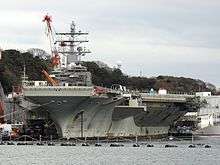
From 10 January, the ship began a period of Selected Restricted Availability with a focus on part of the ship including the flight deck, hangar bays, and general living spaces.[52][53] On 19 April the ship was visited by Vice President Mike Pence.[54][55] On 7 May, the ship put to sea for sea trials before her annual patrol.[56] Following a short period of sea trials, Ronald Reagan returned to port, then left again on her annual cruise on 16 May, to relieve her sister ship Carl Vinson, which had been deployed near North Korea in light of political tensions.[57][58]
She visited Singapore in June[59] and then sailed to Australia where she participated the Talisman Saber exercise with Australian and other forces in July.[60] She then made a port visit to Brisbane[61] before returning to Japan on 9 August.[62] On 8 September she departed Yokosuka again to conduct patrols off Korea after the North Korean missile launch over Japan and nuclear test.[63][64] In early October the ship visited Hong Kong.[65] She then participated in drills with the Japan Maritime Self-Defense Force off Okinawa.[66] After that, Ronald Reagan participated in drills off the Korean peninsula with the South Korean Navy.[67] After the drills, she made a port visit at Busan in South Korea.[68][69][70]
On 29 October, Ronald Reagan scrambled an undisclosed number of Super Hornets to intercept two Russian Tu-95MS bombers on a Tokyo Express flight near Japan that were heading towards the carrier. The Russian bombers were accompanied by their own Su-35S escort fighters. During their flights the bombers were also intercepted by F-2, F-4 and F-15 fighters of the Japan Air Self-Defense Force.[71][72][73] In November destroyers assigned to Ronald Reagan conducted exercises with the Indian Navy[74] after which the Indian Navy ships and a Japan Self-Defense Force destroyer conducted exercises with Ronald Reagan.[75]
Later in November the vessel conducted drills with two other US aircraft carriers, Nimitz and Theodore Roosevelt. It was the first time in a decade that three US carrier strike groups had operated together in Asia. They were also joined by the Japanese helicopter destroyer Ise and the guided missile destroyers Inazuma and Makinami. After working with the Japanese warships the carrier groups conducted drills with seven South Korean vessels, including two Aegis-equipped destroyers. The drills were timed to coincide with the Asian tour of US President Donald Trump amid tensions with North Korea.[76][77][78]
.jpg)
On 22 November, a C-2A Greyhound cargo plane of VRC-30 with 11 crew and passengers aboard crashed into the Philippine Sea 145km northwest of Okinotorishima while flying from Marine Corps Air Station Iwakuni to the carrier. It was the first C-2 loss since 2005,[79], and the first fatal crash since 1973. Eight of the 11 were rescued.[80][81][82][83][84][85] Ronald Reagan returned to Yokosuka on 4 December.[86][87]
2018
From 17 May Ronald Reagan conducted sea trials, and on 28 May 2018 she departed on her regular patrol of the Pacific.[88][89][90][91] Her departure was several weeks late. The delay was caused by a "material issue" that required repairs discovered during the sea trials. Field Carrier Landing Practice for aircrew on Iwo Jima were also delayed.[92][93] After patrolling through the disputed South China Sea, the ship visited the Philippines for the first time,[94][95] and stayed for four days.[96]
From 7 to 16 June the carrier participated in the Malabar 2018 exercise with Japan and India near Guam.[97][98][99][100] Ronald Reagan returned to Yokosuka on 24 July.[101][102][103] On 27 July along with other vessels she left port again to avoid Typhoon Jongdari,[104] returning on 30 July.[105] She left port again ahead of a typhoon on 7 August.[106] On 31 August 2018, the carrier conducted training with the Izumo-class helicopter destroyer Kaga, of the Japan Maritime Self-Defense Force.[107]
Gallery
Click on the thumbnail to enlarge.
 Ronald Reagan is aided by harbor tugs as it enters Pearl Harbor, Hawaii, for a port visit on 28 June 2006.
Ronald Reagan is aided by harbor tugs as it enters Pearl Harbor, Hawaii, for a port visit on 28 June 2006. Sailors aboard Ronald Reagan man the rails as the supercarrier arrives at her new homeport in San Diego, California, on 23 July 2004.
Sailors aboard Ronald Reagan man the rails as the supercarrier arrives at her new homeport in San Diego, California, on 23 July 2004. US Marines and sailors man the rails aboard Ronald Reagan as the ship transits Pearl Harbor in Hawaii on 28 June 2010 to participate in the 22nd RIMPAC (Rim of the Pacific) exercises.
US Marines and sailors man the rails aboard Ronald Reagan as the ship transits Pearl Harbor in Hawaii on 28 June 2010 to participate in the 22nd RIMPAC (Rim of the Pacific) exercises._2012-01-10_(cropped).jpg) Two AN/SPN-46 radars used on Ronald Reagan
Two AN/SPN-46 radars used on Ronald Reagan Sailors on the flight deck of Ronald Reagan stand by as an SH-60F Seahawk assigned to the Black Knights Helicopter Anti-Submarine Squadron 4 delivers cargo during a vertical replenishment. HS-4 is embarked aboard Ronald Reagan completing a Composite Training Unit Exercise in preparation for an upcoming deployment. 3 November 2010
Sailors on the flight deck of Ronald Reagan stand by as an SH-60F Seahawk assigned to the Black Knights Helicopter Anti-Submarine Squadron 4 delivers cargo during a vertical replenishment. HS-4 is embarked aboard Ronald Reagan completing a Composite Training Unit Exercise in preparation for an upcoming deployment. 3 November 2010_in_Santa_Barbara%2C_May_31st%2C_2014.jpg) Ronald Reagan in Santa Barbara, 31 May 2014, photo taken at Shoreline Park, Santa Barbara, California
Ronald Reagan in Santa Barbara, 31 May 2014, photo taken at Shoreline Park, Santa Barbara, California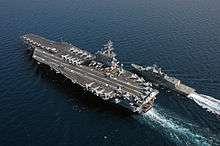 Ronald Reagan makes final preparations to provide fuel to the Royal Australian Navy frigate HMAS Ballarat during a Fueling At Sea (FAS) evolution, 21 April 2006
Ronald Reagan makes final preparations to provide fuel to the Royal Australian Navy frigate HMAS Ballarat during a Fueling At Sea (FAS) evolution, 21 April 2006 An F/A-18F Super Hornet assigned to the "Black Knights" of Strike Fighter Squadron 154 lands on the flight deck of Ronald Reagan while the carrier is underway in the Pacific Ocean conducting Tailored Ships Training Availability 17 June 2010
An F/A-18F Super Hornet assigned to the "Black Knights" of Strike Fighter Squadron 154 lands on the flight deck of Ronald Reagan while the carrier is underway in the Pacific Ocean conducting Tailored Ships Training Availability 17 June 2010
See also
References
- ↑ Polmar, Norman (2004). The Naval Institute guide to the ships and aircraft of the U.S. fleet. Naval Institute Press. p. 112. ISBN 978-1-59114-685-8.
- ↑ "USS Ronald Reagan Departs on Third Deployment". United States Navy. 20 May 2008. Retrieved 24 June 2008.
- 1 2 Hlavac, Tyler (9 October 2015). "Public can tour USS Ronald Reagan Monday in Japan". Stars and Stripes. Retrieved 7 June 2016.
- ↑ Pike, John. "CVN-76 Ronald Reagan". Retrieved 24 February 2017.
- ↑ "Ronald Reagan (CVN 76) Christening: Advanced Media Kit" (PDF). Northrop Grumman Shipbuilding. Retrieved 27 December 2009.
- ↑ Boyle, Scott (2 November 2002). "Another Milestone Passed on Road to Commissioning". U.S. Navy. Archived from the original on 13 September 2009. Retrieved 19 March 2011.
- ↑ "USS Ronald Reagan Commemorates Former President's 90th Birthday". CNN. 4 March 2001. Retrieved 24 January 2008.
- ↑ reagan.navy.mil Archived 29 December 2008 at the Wayback Machine.
- ↑ Journalist 2nd Class Shane Tuck, USN (12 May 2004). "USS Ronald Reagan Certified Battle Ready". NNS040512-07. USS Ronald Reagan Public Affairs. Retrieved 9 January 2011.
- ↑ "US jet crashes off Queensland". Australian Broadcasting Corporation. 30 January 2006. Retrieved 11 August 2016.
- ↑ F-18 Crash video. United States Navy. 28 January 2006. Retrieved 8 February 2009.
- ↑ "Mighty warship feels the sting | NEWS.com.au". 26 October 2007. Archived from the original on 26 October 2007. Retrieved 24 July 2017.
- ↑ Ross, John (2 March 2015). "The jellyfish are coming". The Australian. Retrieved 24 July 2017.
- ↑ "USS Ronald Reagan Departs on Maiden Deployment". U.S. Navy. 4 January 2006. Retrieved 19 March 2011.
- ↑ "Ronald Reagan Carrier Strike Group Returns Following 6-Month Deployment". U.S. Navy. 6 July 2006. Archived from the original on 13 September 2009. Retrieved 19 March 2011.
- ↑ "Ronald Reagan Strike Group Departs San Diego on Surge Deployment" (Press release). USS Ronald Reagan Public Affairs. 27 January 2007. Archived from the original on 28 February 2007. Retrieved 10 March 2007.
- ↑ "Ronald Reagan Awarded First Battle "E"". U.S. Navy. 28 February 2007. Archived from the original on 21 July 2010. Retrieved 19 March 2011.
- ↑ Ronald Reagan and HS-4 Medevac 14 Year-Old Girl From Cruise Ship.
- ↑ USS Ronald Reagan Service History.
- ↑ "US ship coming to help retrieve victims of sea tragedy". Retrieved 24 February 2017.
- ↑ Carlstrom, Kyle (22 February 2009). "USS Ronald Reagan Wins Second Battle E". U.S. Navy. Archived from the original on 13 September 2009. Retrieved 19 March 2011.
- ↑ Affairs, This story was written by Carrier Strike Group 7 Public. "USS Ronald Reagan Deploys". Retrieved 24 February 2017.
- ↑ Neely, Frank E. (23 October 2009). "Ronald Reagan Carrier Strike Group Returns Home". U.S. Navy. Archived from the original on 25 October 2009. Retrieved 19 March 2011.
- ↑ Tidd, Alex (8 April 2010). "Ronald Reagan Wins CNO Safety Award". U.S. Navy. Archived from the original on 5 August 2012. Retrieved 19 March 2011.
- ↑ Brotzman, Briana C. (11 February 2010). "USS Ronald Reagan Wins Third Battle "E" Award". U.S. Navy. Retrieved 19 March 2011.
- 1 2 "Norfolk Naval Shipyard Completes CVN 76's Planned Incremental Availability". NNS100520-1. Norfolk Naval Shipyard Public Affairs. 20 May 2010. Retrieved 28 December 2011.
- 1 2 3 4 Lee, MCS2 (SW/AW) Torrey W. (21 May 2010). "Ronald Reagan Ready for Sea After Successful Sea Trials". NNS100521-03. USS Ronald Reagan Public Affairs.
- ↑ "USS Ronald Reagan Underway for Sea Trials". NNS100518-06. USS Ronald Reagan Public Affairs. 18 May 2010. Retrieved 28 December 2011.
- 1 2 3 "2010 History". USS Ronald Reagan CVN-76. USCarriers.net. 16 November 2011. Retrieved 29 December 2012.
- 1 2 Mass Communication Specialist 2nd Class (SW/AW) Torrey W. Lee, USN (3 June 2010). "Ronald Reagan Begins Flight Deck Certification". NNS100603-15. USS Ronald Reagan Public Affairs. Retrieved 28 December 2011.
- ↑ Vercammen, Paul (11 November 2010). "Crippled cruise ship expected in San Diego on Thursday". CNN. Retrieved 11 November 2010.
- ↑ King, Laura; Magnier, Mark; Demick, Barbara (13 March 2011). "Japan faces soaring number of feared dead". Los Angeles Times. p. 3 (online). Retrieved 16 February 2015.
The nuclear-powered ship [USS Ronald Reagan] is being used as a floating refueling station for Japanese military and coast guard helicopters flying rescue missions in the area and delivering emergency food supplies.
- ↑ "USS Ronald Reagan measured 0.6 mR/hr direct gamma shine from clouds 130 miles from Fukushima Daiichi". Enformable: Nuclear News. 13 March 2011. Retrieved 16 February 2015.
...they went up to 130 miles or from the plant, and we were still reading a direct gamma shine of 0.6 millirem per hour.
- ↑ The Stream Team (16 December 2013). "USS Ronald Reagan sailors report cancers after Fukushima rescue mission". aljazeera.com. Al Jazeera America. Retrieved 16 December 2013.
- ↑ Brazell, Karen (23 March 2011). "Photo: A super-size scrub". PBS.org. Retrieved 16 December 2013.
- ↑ "Japanese defense chief thanks U.S. military for humanitarian efforts". Kyodo News. 4 April 2011.
- ↑ Kovach, Gretel C. (9 September 2011). "Carrier Ronald Reagan Due Home After Eventful Deployment". San Diego Union-Tribune.
- ↑ "USS Ronald Reagan Coming to Bremerton in 2012". House.gov. Archived from the original on 1 August 2012. Retrieved 17 August 2012.
- ↑ "USS Ronald Reagan returns to San Diego after more than a year in Washington state". 10News.com. Retrieved 21 March 2013.
- ↑ "Why aircraft carriers may be good for parking cars but not landing new jets". Retrieved 24 February 2017.
- ↑ "The world's most exclusive parking lot? Aircraft carrier transports sailors' cars to ship's new home". Retrieved 24 February 2017.
- ↑ Affairs, This story was written by U.S. Pacific Fleet Public. "Navy Aircraft Carrier Moves Underscore Pacific Rebalance Strategy". Retrieved 24 February 2017.
- ↑ Slavin, Erik Russian aircraft approach USS Ronald Reagan, prompting US fighter jet scramble 29 October 2015 Stars and Stripes Retrieved 25 September 2017
- ↑ Kimber, James USS Ronald Reagan pulls into Busan after joint drills 30 October 2015 Stars and Stripes Retrieved 25 September 2017
- ↑ Cavas, Christopher P. (6 June 2016). "US Navy Deploys Most Carrier Strike Groups Since 2012". defensenews.com. Retrieved 7 June 2016.
- ↑ "U.S. Carrier 'Ronald Reagan' Targeted by Several Dozen Chinese Anti -Ship Missiles in July". newsline.com. 30 December 2016. Archived from the original on 31 December 2016. Retrieved 1 January 2017.
- ↑ Burke, Nathan Ronald Reagan Returns to Yokosuka for Mid-Patrol Break 26 July 2016 Retrieved 11 August 2016
- ↑ USS Ronald Reagan tweet 30 August 2016 Retrieved 10 September 2016
- ↑ Johnson, Jesse U.S.-South Korean joint naval drills kick off; nuclear-powered USS Ronald Reagan set to take part 10 October 2016 Japan Times
- ↑ Hlavac, Tyler USS Ronald Reagan returns to Yokosuka after 3-month patrol 21 November 2017 Stars and Stripes Retrieved 10 September 2017
- ↑ USS Ronald Reagan begins 2017 Selected Restricted Availability 1 January 2017 Defense Video Imagery Distribution System Retrieved 27 February 2017
- ↑ USS Ronald Reagan begins SRA maintenance period in Japan 11 January 2017 Naval Today Retrieved 27 February 2017
- ↑ "Vice President Mike Pence Visits USS Ronald Reagan". navylive.mil. 18 April 2017. Retrieved 9 November 2017.
- ↑ "The Latest: Pence, on US Carrier, Pledges to Defend Asia". 18 April 2017. Retrieved 9 November 2017.
- ↑ Cohen, Zachary (9 May 2017). "USS Ronald Reagan preps to replace Carl Vinson in Pacific". cnn.com. Retrieved 17 May 2017.
- ↑ Tritten, Travis J (16 May 2017). "Aircraft carrier Reagan leaves port to relieve Vinson strike group amid North Korea tensions". Washington Examiner. Retrieved 17 May 2017.
- ↑ Kosaka, Tetsuro (17 May 2017). "USS Ronald Reagan leaves Yokosuka base". The Nikkei. Archived from the original on 17 May 2017. Retrieved 17 May 2017.
- ↑ USS Ronald Reagan underway again after Singapore visit 22 June 2017 Naval Today Retrieved 14 July 2017
- ↑ USS Ronald Reagan Begins Exercise Talisman Saber 2017 10 July 2017 pack.mil Retrieved 14 July 2017
- ↑ Hamilton-Smith, Lexy (24 July 2017). "USS Ronald Reagan arrives into Brisbane port, thousands of US sailors to holiday". Australia: ABC. Retrieved 26 January 2018.
- ↑ USS Ronald Reagan returns to Yokosuka after nearly 3-month deployment 9 August 2017 Stars and Stripes Retrieved 10 August 2017
- ↑ Japan-based U.S. carrier leaves Yokosuka on surveillance mission amid North Korea tensions 8 September 2017 Japan Times Retrieved 10 September 2017
- ↑ USS Ronald Reagan departs Japan for regional patrol 7 September 2017 Retrieved 10 September 2017
- ↑ "Thousands of US Navy officers arrive in Hong Kong for USS Ronald Reagan port of call". South China Morning Post. 3 October 2017. Retrieved 18 October 2017.
- ↑ Kelly, Tim (11 October 2017). "US aircraft carrier drills with Japan as Air Force B-1 bombers buzz North Korea". Business Insider. Retrieved 18 October 2017.
- ↑ Gady, Franz-Stefan (16 October 2017). "US, ROK Navies Hold Military Drill off Korean Peninsula". The Diplomat. Retrieved 18 October 2017.
- ↑ Fictl, Michael (21 October 2017). "USS Ronald Reagan visits S. Korean port after weeklong joint naval drills". Retrieved 8 November 2017.
- ↑ "USS Ronald Reagan pulls into Busan, South Korea". navaltoday.com. 23 October 2017. Retrieved 8 November 2017.
- ↑ "USS Ronald Reagan docks in South Korean port after large-scale drills". 22 October 2017. Retrieved 8 November 2017.
- ↑ Hodge Seck, Hope (1 November 2017). "The Ronald Reagan scrambled multiple fighter jets to escort Russian bombers away from the carrier". Retrieved 8 November 2017.
- ↑ Hollings, Alex (2 November 2017). "USS Ronald Reagan scrambles fighters to intercept approaching Russian bombers in the Pacific". sofrep.com. Retrieved 8 November 2017.
- ↑ Gady, Franz-Stefan (2 November 2017). "US Aircraft Carrier Scrambles Jets to Intercept Russian Strategic Bombers". The Diplomat. Retrieved 8 November 2017.
- ↑ "Indian Navy ships conduct PASSEX with Ronald Reagan Strike Group destroyers". 6 November 2017.
- ↑ "U.S. Navy carrier drills with Japanese, Indian navy in Sea of Japan". 7 November 2017. Retrieved 8 November 2017.
- ↑ Johnson, Jesse (12 November 2017). "Japanese warships join three U.S. aircraft carriers for massive display of military might". Japan Times. Retrieved 15 November 2017.
- ↑ Lendon, Brad (14 November 2017). "North Korea: 3 US aircraft carriers creating 'worst ever' situation". CNN. Retrieved 15 November 2017.
- ↑ Gady, Franz-Stefan (13 November 2017). "3 US Carrier Strike Groups Hold Massive Naval Drill with South Korean, Japanese Navies in Western Pacific". thediplomat.com. Retrieved 15 November 2017.
- ↑ Mizokami, Kyle (26 November 2017). "U.S. Navy Transport Crashes En Route to Aircraft Carrier". popularmechanics.com. Popular Mechanics. Retrieved 30 November 2017.
- ↑ "US Navy C-2 Greyhound crashes in Philippine Sea". Flight Global. 22 November 2017. Retrieved 23 November 2017.
- ↑ Rich, Motoko (22 November 2017). "Navy Aircraft With 11 Aboard Crashes Into Waters Off Japan". New York Times. Retrieved 22 November 2017.
- ↑ Lockie, Alex (22 November 2017). "US Navy plane carrying 11 crashes in the Philippine Sea en route to aircraft carrier". businessinsider.com. Business Insider. Retrieved 23 November 2017.
- ↑ Walters, Joanne (23 November 2017). "Three missing after US navy plane crashes in Philippine Sea". theguardian.com. The Guardian. Retrieved 23 November 2017.
- ↑ Cenciotti, David (22 November 2017). "U.S. Navy C-2A Aircraft Carrying 11 Crew And Passengers Crashed In The Ocean Southeast Of Okinawa". theaviationist.com. Retrieved 23 November 2017.
- ↑ "Search Ends For Sailors in C-2A Crash". navy.mil. 23 November 2017. Retrieved 25 November 2017.
- ↑ Hlavac, Tyler (4 December 2017). "Families welcome USS Ronald Reagan home to Japan after 'tough' fall deployment". stripes.com. Stars and Stripes. Retrieved 6 December 2017.
- ↑ Maeda, Motoyuki (4 December 2017). "USS Ronald Reagan back in Yokosuka after show of strength". Asahi Shimbun. Retrieved 6 December 2017.
- ↑ "Ronald Reagan Strike Group departs for patrol". www.c7f.navy.mil. United States Navy. 28 May 2018. Retrieved 30 May 2018.
- ↑ "USS Ronald Reagan aircraft carrier leaves Yokosuka base for regional patrol". Japan Times. 29 May 2018. Retrieved 1 June 2018.
- ↑ Gady, Franz-Stefan (30 May 2018). "US Navy Carrier Strike Group Departs for Patrol in Western Pacific Ocean". The Diplomat. Retrieved 1 June 2018.
- ↑ Lagazo, Janweb (3 June 2018). "Ronald Reagan Welcomes CVW-5". c7f.navy.mil. Retrieved 8 June 2018.
- ↑ Doornbos, Catlin (17 May 2018). "'Material issue' delays USS Ronald Reagan's upcoming deployment". Stars and Stripes. Retrieved 5 June 2018.
- ↑ Ziezulewicz, Geoff (1 June 2018). "The carrier Ronald Reagan was late to deploy last month — here's why". Navy Times. Retrieved 5 July 2018.
- ↑ "WATCH: USS Ronald Reagan docks in the Philippines for the first time". Rappler. 27 June 2018. Retrieved 5 July 2018.
- ↑ Doornbos, Caitlin (27 June 2018). "7th Fleet ships stop in the Philippines, 'a favorite port visit for sailors'". Stars and Stripes. Retrieved 5 July 2018.
- ↑ Esmaquel, Paterno (4 July 2018). "3 U.S. carrier visits to Philippines show America cares – envoy". Rappler. Retrieved 5 June 2018.
- ↑ "Indian, Japanese and U.S. maritime forces to participate in exercise Malabar 2018". japan.stripes.com. 4 June 2018. Retrieved 27 July 2018.
- ↑ Gady, Franz-Stefan (5 June 2018). "India, US, and Japan to Hold 'Malabar' Naval War Games This Week". The Diplomat. Retrieved 27 July 2018.
- ↑ "Malabar 2018: All you need to know about the trilateral naval exercise". 15 June 2018. Retrieved 27 July 2018.
- ↑ "Malabar 2018 concludes off Guam". navaltoday.com. 20 June 2018. Retrieved 27 July 2018.
- ↑ "Ronald Reagan Strike Group Returns From Patrol". 23 July 2018. Retrieved 28 July 2018.
- ↑ Doornbos, Caitlin (24 July 2018). "USS Ronald Reagan returns to Yokosuka after 2-month deployment". Stars and Stripes. Retrieved 27 July 2018.
- ↑ Soule, Codie (27 July 2018). "Ronald Reagan Strike Group returns from patrol". Retrieved 27 July 2018.
- ↑ Doornbos, Caitlyn (27 July 2018). "Many 7th Fleet vessels ship out ahead of incoming Typhoon Jongdari". Stars and Stripes. Retrieved 27 July 2018.
- ↑ "M'18/7/30 松辰(USS RONALD REAGAN. CVN-76入港 港めぐりより)". youtube.com. 30 July 2018. Retrieved 30 July 2018.
- ↑ "M'18/8/7 松辰 横須賀軍港(CVN-76 USS RONALD REAGAN. 2回目の台風避難へ)". YouTube.com. August 9, 2018. Retrieved September 2, 2018.
- ↑ Japanese helicopter destroyer trains with U.S. aircraft carrier in disputed South China Sea September 1, 2018 Japan Times Retrieved September 1, 2018
External links
| Wikimedia Commons has media related to: |